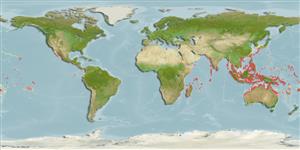Common names from other countries
Environment: milieu / climate zone / depth range / distribution range
Ökologie
seewasser riff-verbunden; tiefenbereich 1 - 15 m (Ref. 86942). Tropical
Indo-West Pacific: Sri Lanka to Fiji (Ref. 9710) and Tonga (Ref. 53797), north to Taiwan, south to northern Australia.
Size / Gewicht / Alter
Maturity: Lm ? range ? - ? cm
Max length : 12.0 cm TL Männchen/unbestimmt; (Ref. 2272)
Rückenflossenstacheln (insgesamt): 9; Rückenflossenweichstrahlen (insgesamt): 11-12; Afterflossenstacheln 3; Afterflossenweichstrahlen: 11 - 12; Wirbelzahl: 25. Young green when in seagrasses and greenish brown on reefs. Recognized by the unusual color patterns on the cheek or the black spotted scales over the back (Ref. 48636). Preserved male specimens with pale spots on scales; dark spot behind eye (continuous with a bifurcating dark band which extends ventrally); another on opercle; a dark band on snout from upper lip to eye; head with bands; spot on upper caudal base may be present or absent (present in females). Anterior lateral line scales with 1-3 pores (usually 2); 5-6 suborbital pores. Anterior dorsal and anal soft rays longer than posterior rays; pelvic fins of males relatively short, not reaching anus.
Found usually in groups (Ref. 90102) in shallow coastal reefs and seagrass flats (Ref. 9710), also in algae-rocky reef flats and lagoons (Ref. 48636).
Life cycle and mating behavior
Geschlechtsreife | Fortpflanzung | Ablaichen | Eier | Fecundity | Larven
Randall, J.E., 1980. Two new Indo-Pacific labrid fishes of the genus Halichoeres, with notes on other species of the genus. Pac. Sci. 34(4):415-432. (Ref. 2136)
IUCN Rote Liste Status (Ref. 130435)
CITES (Ref. 128078)
Not Evaluated
Bedrohung für Menschen
Harmless
Nutzung durch Menschen
Fischereien: weniger kommerziell; Aquarium: Kommerziell
Mehr Information
NamenSynonymeMetabolismusRäuberÖkotoxikologieFortpflanzungGeschlechtsreifeAblaichenFecundityEierEientwicklung
ReferenzenAquakulturAquakultur ProfilZuchtlinienGenetikElectrophoresesVererbbarkeitKrankheitenVerarbeitungMass conversion
PartnerBilderStamps, Coins Misc.LauteCiguateraGeschwindigkeitSchwimmstilKiemenoberflächeOtolithsGehirngrößeSehfähigkeit
Tools
Zusatzinformationen
Download XML
Internet Quellen
Estimates based on models
Preferred temperature (Ref.
115969): 25.1 - 29.3, mean 28.5 (based on 2913 cells).
Phylogenetic diversity index (Ref.
82804): PD
50 = 0.5000 [Uniqueness, from 0.5 = low to 2.0 = high].
Bayesian length-weight: a=0.00813 (0.00473 - 0.01397), b=3.05 (2.90 - 3.20), in cm Total Length, based on LWR estimates for this species & Genus-body shape (Ref.
93245).
Trophic level (Ref.
69278): 3.4 ±0.5 se; based on size and trophs of closest relatives
Widerstandsfähigkeit (Ref.
120179): hoch, Verdopplung der Population dauert weniger als 15 Monate. (Preliminary K or Fecundity.).
Fishing Vulnerability (Ref.
59153): Low vulnerability (10 of 100).
